*NURSING > QUESTIONS & ANSWERS > Nursing School Entrance Exams Prep 2019–2020: Practice Test One, Kaplan Includes Answer Key with A (All)
Nursing School Entrance Exams Prep 2019–2020: Practice Test One, Kaplan Includes Answer Key with Answers and Explanations
Document Content and Description Below
Nursing School Entrance Exams Prep 2019–2020 Practice Test One, Kaplan READING COMPREHENSION Questions 1–2 are based on the following passage. Many mammals instinctively raise their fur when th... ey are cold—a reaction produced by tiny muscles just under the skin that surround hair follicles. When the muscles contract, the hairs stand up, creating an increase in air space under the fur. The air space provides more effective insulation for the mammal’s body, thus allowing it to retain more heat for longer periods of time. Some animals also raise their fur when they are challenged by predators or even other members of their own species. The raised fur makes the animal appear slightly bigger, and, ideally, more powerful. Interestingly, though devoid of fur, humans still retain this instinct. So, the next time a horror movie gives you “goosebumps,” remember that your skin is following a deep- seated mammalian impulse now rendered obsolete. 1. The increased air space under the fur mentioned in the passage primarily serves which purpose? (A) To combat cold. (B) To intimidate other animals. (C) To render goosebumps obsolete. (D) To cool overheated predators. 2. Based on the passage, the author would MOST likely agree with which statement? (A) Goosebumps in humans are an unnecessary and unexplained phenomenon. (B) Goosebumps in humans are a harmful but necessary measure. (C) Goosebumps in humans are an amusing but dangerous feature. (D) Goosebumps in humans are a useless but interesting remnant. Questions 3–4 are based on the following passage. While it is often helpful to think of humans as simply another successful type of mammal, a vital distinction remains. When a pride of lions enjoys a surfeit of food, they are likely to hunt quickly, eat all they can, and then spend the remainder of the day sleeping. When people enjoy such easy living, we see a markedly different pattern— our big brains cause us to be restless, and we engage in play. This takes the form of art, philosophy, science, even government. So, the intelligence and curiosity that allowed early humans to develop agriculture, and thus a caloric surplus, also led to the use of that surplus as a foundation for culture. 3. Which is the author’s purpose in citing the behavior of lions in the passage? (A) To provide an example of an even more successful mammalian species. (B) To question the efficiency of the lion’s feeding behavior. (C) To provide a contrast to the image of humans as industrious and resourceful. (D) To help illustrate the distinguishing characteristic of humans that led to the development of culture. 4. Which is the main purpose of the final sentence of the passage (“So, the intelligence . . . for culture”)? (A) Illustrate the significance of a distinction. (B) Counter a likely objection. (C) Provide an alternative explanation. (D) Suggest future implications of a phenomenon. Questions 5–8 are based on the following passage. City parks were originally created to provide the local populace with a convenient refuge from the crowding and chaos of their surroundings. Until quite recently, these parks served their purpose admirably. Whether city dwellers wanted to sit under a shady tree to think or take a vigorous stroll to get some exercise, they looked forward to visiting these nearby oases. Filled with trees, shrubs, flowers, meadows, and ponds, city parks were a tranquil spot in which to unwind from the daily pressures of urban life. They were places where people met their friends for picnics or sporting events. And they were also places to get some sun and fresh air in the midst of an often dark and dreary environment, with its seemingly endless rows of steel, glass, and concrete buildings. For more than a century, the importance of these parks to the quality of life in cities has been recognized by urban planners. Yet city parks around the world have been allowed to deteriorate to an alarming extent in recent decades. In many cases, they have become centers of crime; some city parks are now so dangerous that local residents are afraid even to enter them. And the great natural beauty that was once their hallmark has been severely damaged. Trees, shrubs, flowers, and meadows have withered under the impact of intense air pollution and littering, and ponds have been fouled by untreated sewage. This process of progressive decline, however, is not inevitable. A few changes can turn the situation around. First, special police units, whose only responsibility would be to patrol city parks, should be created to ensure parks remain safe for those who wish to enjoy them. Second, more caretakers should be hired to care for the grounds and, in particular, to collect trash. Beyond the increased staffing requirements, it will also be necessary to insulate city parks from their surroundings. Total isolation is, of course, impossible; but many beneficial measures in that direction could be implemented without too much trouble. Vehicles, for instance, should be banned from city parks to cut down on air pollution. And sewage pipes should be rerouted away from park areas to prevent the contamination of land and water. If urban planners are willing to make these changes, city parks can be restored to their former glory for the benefit of all. 5. The author uses the phrase “convenient refuge” to suggest which aspect about parks? (A) They were built in order to preserve plant life in cities. (B) They were designed with the needs of city residents in mind. (C) They were meant to end the unpleasantness of city life. (D) They were supposed to help people make new friends. 6. Which is the reason why the author mentions crime and pollution in the passage? (A) To describe how rapidly the city parks have deteriorated. (B) To describe how city parks can once again be made safe and clean. (C) To explain why people can no longer rest and relax in city parks. (D) To explain why urban planners should not be in charge of city parks. 7. In the last paragraph, the author acknowledges which problem in restoring city parks? (A) The constant need to collect trash. (B) The difficulty in rerouting sewage pipes. (C) The congestion caused by banning vehicular traffic. (D) The lack of total separation from the surrounding city. 8. Based on the passage, which statement is MOST likely true? (A) Modern city parks usually have their own dedicated security forces. (B) Most cities were originally designed with future park needs in mind. (C) Modern city parks face greater challenges than parks faced in the past. (D) Most cities have reduced the number of parks to make room for housing. Questions 9–12 are based on the following passage. The relationship between humans and animals dates back to the misty morning of history. The caves of southern France and northern Spain are full of wonderful depictions of animals. Early African petroglyphs depict recognizable mammals, as does much American Indian art. Even without art, we have evidence of the closeness of humans and animals. The bones of dogs lie next to those of humans in the excavated villages of northern Israel and elsewhere. This unity of death is terribly appropriate. It marks a relationship that is the most ancient of all, one that dates back at least to the Mesolithic Era.* With the dog, the hunter acquired a companion and ally very early on, before agriculture, long before the horse and the cat. The companion animals were followed by food animals, and then by those that provided enhanced speed and range, and finally, by those that worked for us. How did it all come about? A dog of some kind was almost inevitable. Consider its essence: a social carnivore, hunting larger animals across the broad plains it shared with our ancestors. Because of its pack structure, it is susceptible to domination by, and attachment to, a pack leader: the top dog. Its young are born into the world dependent, rearable, without too much skill, and, best of all, they form bonds with the rearers. Dogs have a set of appeasement behaviors that elicit affective reactions from even the most hardened and unsophisticated humans. Puppies share with human babies the power to transform cynics into cooing softies. Furthermore, the animal has a sense of smell and hearing several times more acute than our own, great advantages to a hunting companion and intrusion detector. The dog’s defensive behavior makes it an instinctive guard animal. *Mesolithic Era: the Middle Stone Age, between 8,000 and 3,000 years B.C.E. 9. Which statement BEST explains why the author describes the archeological discoveries in paragraph 1 as “terribly appropriate”? (A) Dogs were always buried next to their owners in the Mesolithic Era. (B) Few animals were of religious significance in prehistoric cultures. (C) They illustrate the role of dogs on a typical hunting expedition. (D) Our relationship with dogs is older than that with any other animal. 10. According to paragraph 1, which kinds of animals were the first to forge a close relationship with humans? (A) Those that acted as companions. (B) Those that provided a source of food. (C) Those that helped develop agriculture. (D) Those that enabled humans to travel farther. 11. According to the author, which is the reason why some kind of dog was “inevitable” as a companion animal for humans? (A) It survived by maintaining its independence. (B) It was stronger than other large animals. (C) It shared its prey with our ancestors. (D) It was suited for human domination. 12. Which term BEST defines the word essence as it is used in paragraph 2 of the passage? (A) History. (B) Nature. (C) Scent. (D) Success. Questions 13–15 are based on the following passage. The learning behavior of many mammals is dictated by instinct but tempered and refined by experience. Very complex behaviors can be learned through individual trial-and-error or practice, as long as that practice is motivated by instinctive drives. For example, predatory cats aren’t born knowing how to hunt, but instinct drives them to stalk, pounce on, and bite things they perceive as prey, and they gradually become more skilled and effective hunters. Wolves aren’t born knowing how to get along with other wolves, but the experience of living in the pack, the correction and support they receive from elders, and the survival instinct that drives them to stay in the pack result in their eventually learning to find their place in the hierarchy and to cooperate in group activities, such as hunting and rearing young. Some kinds of animal learning, however, are not so directly dependent on the need to survive. In the case of primates in particular, evolution seems to have fostered a behavior pattern that encourages restless experimentation and exploration of the environment apart from the search to fulfill basic needs. Among humans, for example, the discovery of the laws of gravity didn’t directly bear on the survival of Sir Isaac Newton; nor did the description of the properties of triangles help Pythagoras put food on the table. Although these discoveries may later have indirectly improved the quality of life and survival potential of the discoverers’ descendants, the lack of an immediate survival imperative suggests that experimentation, discovery, and sharing the benefits of those discoveries have as much to do with enjoyment as with survival. 13. Which term BEST defines the word tempered as it is used in paragraph 1 of the passage? (A) Angered. (B) Commanded. (C) Influenced. (D) Suppressed. 14. Which example is MOST similar to the pattern of learning described in the first paragraph? (A) A hobbyist learns how to knit by reading a book on arts and crafts. (B) Math students learn how to use a geometry formula by watching a teacher demonstrate. (C) A basketball player improves his ability to shoot free throws by practicing every day. (D) A leafcutter ant hatches knowing how to find leaves and then learns how to harvest them. 15. Why does the author list famous discoverers in paragraph 2? (A) To illustrate human superiority over other animals. (B) To prove an argument about the way that discoveries benefit later generations. (C) To suggest that discoveries are usually accidental. (D) To demonstrate that discoveries aren’t always inspired by a need to survive. WRITING Questions 1–5 are based on the following passage. 1A major story in recent years has been the triumph of electronic mail, commonly known as email. 2Since the early 1990s, email users have multiplied exponentially. 3Many major corporations have chosen email as their primary channel for all communications, internal and external. 4By 2017, an average of 269 billion emails were being sent every single day around the world—equal to more than 35 messages per day for every single person on the planet. 5Yet, however affective and inexpensive email may be, it is not without flaws. 6The medium is impersonal, lacking the intimacy of a letter or the immediacy of a phone call. 7In centuries past, people wrote letters by hand: and some of those have even survived as historical artifacts. 8As an interactive medium, email is less than ideal, since messages allow correspondents to politely ignore points they do not wish to address, or indeed not to respond at all. 9Email have also brought with it a number of ethical issues. 10For example, if employers provide email services for their employees, should those employers be allowed to access employee emails without permission? 11If an employee sends harassing or threatening messages through company email services, should the employer be held responsible? 1. Which sentence should be deleted because it is unrelated to the other sentences in the paragraph? (A) Sentence 3. (B) Sentence 4. (C) Sentence 7. (D) Sentence 8. 2. Which word in the first paragraph is incorrect? (A) Exponentially. (B) Affective. (C) Immediacy. (D) Correspondents. 3. Which sentence has incorrect subject-verb agreement? (A) Sentence 4. (B) Sentence 7. (C) Sentence 9. (D) Sentence 11. 4. Where is the BEST place to add this sentence? Despite these potential challenges, email has become an integral part of how humans communicate and is likely to remain with us for years to come. (A) Following sentence 5. (B) Following sentence 7. (C) Following sentence 9. (D) Following sentence 11. 5. Which choice describes how to correct a punctuation error in the passage? (A) Remove the comma after the word communications in sentence 3. (B) Add a comma after the word however in sentence 5. (C) Change the comma after the word impersonal in sentence 6 to a semicolon. (D) Change the colon after the word hand in sentence 7 to a comma. Questions 6–10 are based on the following passage. 1When commercial fish farming—a technique that applies the breeding structures used for raising animals on land to the ocean— was first introduced, it was seen as a creative alternative to the depletion of the world’s large finfish and shellfish populations through conventional harvesting methods. 2Through careful planning, fish farmers could also reliably project how many fish they would be able to harvest in a certain enclosure over a specific amount of time, eliminated the risk of a potential “bad season” of fishing. 3New research however, is causing some to reconsider their initial enthusiasm for fish farming. 4About 29 million tons of large finfish were farmed in 1997, no doubt a significant contribution to the world’s fish supplies. 5Unfortunately, the cost of this production was roughly 10 million tons of smaller wild fish used as feed, an amount that, if perpetuated, could soon virtually obliterate the world’s supply of small fish. 6Another danger posed by fish farms is a result of placing so many fish in such a small area: diseases and parasites can spread rapidly, devestating an entire population of fish before the problem can be addressed. 7While fish farming might prove to be a smart way to keep from depleting ocean life, it has also created a whole new realm of challenges that the industry must face to achieve success too. 6. Which sentence includes an unnecessary word? (A) Sentence 1 includes the unnecessary word when. (B) Sentence 3 includes the unnecessary word however. (C) Sentence 6 includes the unnecessary word another. (D) Sentence 7 includes the unnecessary word too. 7. Which word in the second paragraph is incorrect? (A) Enthusiasm. (B) Perpetuated. (C) Devestating. (D) Achieve. 8. Which sentence has an incorrect form of a verb? (A) Sentence 2. (B) Sentence 4. (C) Sentence 5. (D) Sentence 7. 9. Where is the BEST place to add this sentence? In addition, fish farms could eliminate many of the dangers associated with working in the fishing industry, usually considered one of the most dangerous industries in the world. (A) Following sentence 2. (B) Following sentence 7. (C) Following sentence 9. (D) Following sentence 11. 10. Which sentence includes an error in punctuation? (A) Sentence 2. (B) Sentence 3. (C) Sentence 4. (D) Sentence 6. Questions 11–14 are based on the following passage. 1With an estimated 200 million cases and nearly a million resulting deaths per year, malaria is the world’s number-one public health problem, especially in tropical and subtropical regions. 2The struggle with this infection is nothing new—malaria is mentioned in some of the earliest medical records of Western civilization. 3We know for example, that the ancient Greek physician Hippocrates identified three types of malarial fevers in the fifth century B.C.E. 4By the late fifteenth century, malaria had spread to the Americas, likely as the result of European explorers. 5In addition to bringing disease, European explorers often devastated indigenous populations through warfare and forced labor. 6Two of the most important factors in the proliforation of malaria are climate and poverty. 7The mosquito that spreads the disease requires a relatively warm and wet environment to flourish. 8This means that tropical regions are at the greatest risk of the disease. 9Areas of high poverty are less likely to have proper water drainage or fully enclosed living areas, and may not have access to inexpensive preventatives such as mosquito nets and insect repellents; this puts the poor at greater risk of contracting the disease. 11. Which word in the second paragraph is incorrect? (A) Proliforation. (B) Environment. (C) Flourish. (D) Preventatives. 12. Which choice describes how to correct a punctuation error in the passage? (A) Change the comma after the word problem in sentence 1 to a colon. (B) Add a comma after the word know in sentence 3. (C) Change the comma after the word Americas in sentence 4 to a period, and start a new sentence with the word likely. (D) Change the semicolon after the word repellents in sentence 9 to a comma. 13. Where is the BEST place to add this sentence? In fact, epidemics in Central America were recorded in 1493, only a year after Columbus’s first voyage there. (A) Following sentence 2. (B) Following sentence 3. (C) Following sentence 4. (D) Following sentence 7. 14. Which sentence contains unnecessary information and should be removed? (A) Sentence 2. (B) Sentence 5. (C) Sentence 6. (D) Sentence 9. MATHEMATICS 1. (A) (B) (C) (D) 2. Which is the value of a(b − 2) + 3c if a = 2, b = 6 and c = 4? (A) 20 (B) 12 (C) 24 (D) 32 3. Andrew bought a camera on sale at a 20% discount. It was marked down from its regular price of $120. If there is an 8% sales tax on the sale price, how much did Andrew pay for the camera? (A) $24.00 (B) $103.68 (C) $127.68 (D) $105.68 4. When z is divided by 8, the remainder is 5. Which is the remainder when 4z is divided by 8?? (A) 1 (B) 3 (C) 4 (D) 5 5. Which is the least common multiple of 12 and 8?? (A) 12 (B) 24 (C) 18 (D) 96 6. Which is the value of x in the equation 6x − 7 = y, if y = 11? (A) 12 (B) 8 (C) 4 (D) 3 7. Edward has $400 more than Robert. After Edward spends $60 on groceries, he has 3 times more money than Robert. How much money does Robert have? (A) $140 (B) $120 (C) $90 (D) $170 8. John bought a camera on sale that normally costs $160. If the price was reduced 20% during the sale, which was the sale price of the camera? (A) $120 (B) $124 (C) $128 (D) $140 9. converted to a percent equals which of the following? (A) 0.025% (B) 0.25% (C) 2.5% (D) 25% 10. (A) (B) (C) (D) 11. Renée’s dress shop is suffering from slow business. Renée decides to mark down all her merchandise. The next day, she sells 33 winter coats. That day Renée sold 30% of the winter coats she had in stock. How many winter coats were in stock before the sale? (A) 990 (B) 99 (C) 110 (D) 1,110 12. If x , y = 2, and , then x2 − 5yz + y2 = ? (A) 1 (B) 2 (C) 4 (D) 7 13. 120.21 + 8.76 − 72.88 = (A) 38.57 (B) 56.09 (C) 62.51 (D) 121.69 14. What is 25% of 25% of 72?? (A) 4 (B) 4.5 (C) 5 (D) 12 15. The price of a stock decreased by 20%. By what percent must the price increase to return to its original value? (A) 25% (B) 50% (C) 20% (D) 120% 16. Mrs. Bailer divides the amount of money she has between her 4 children. Mr. Bailer then adds $2 to the amount each one receives so that each child now has a total of $5.25.Which equation shows this relationship? (A) 4x + 2 = 5.25 (B) (C) 4x = 5.25 + 2 (D) 4(x + 2) = 5.25 17. (A) 0.014 (B) 0.14 (C) 1.4 (D) 14 SCIENCE 1. Which answer option facilitates the diffusion of water into and out of cells? (A) Carrier proteins. (B) Symport systems. (C) Ion channels. (D) Osmosis. 2. Which association of brain structure and function is false? (A) Hypothalamus: Appetite. (B) Cerebellum: Motor coordination. (C) Cerebral cortex: Higher intellectual function. (D) Medulla: Basic emotional drives. 3. The absorption of oxygen from the atmosphere into the blood takes place in which structure? (A) Pulmonary artery. (B) Pulmonary vein. (C) Alveoli. (D) Trachea. 4. In which structure does filtration of the blood occur? (A) The ureters. (B) The nephrons. (C) The renal veins. (D) The renal arteries. 5. Which blood component transports oxygen? (A) Plasma. (B) Platelets. (C) Leukocytes. (D) Erythrocytes. 6. Which structure does NOT transport oxygen-depleted blood to the right atrium of the heart? (A) The pulmonary veins. (B) The coronary sinus. (C) The superior vena cava. (D) The inferior vena cava. 7. Hormone regulation in the body is mainly governed by which system? (A) Muscular system. (B) Endocrine system. (C) Nervous system. (D) Digestive system. 8. Which term describes a state of low blood pH? (A) Acidemia. (B) Acidosis. (C) Alkalemia. (D) Alkalosis. 9. Which answer option is not a function of the large intestine? (A) Nutrient absorption. (B) Compaction of feces. (C) Filtration of damaged or dead blood cells. (D) Water reabsorption. 10. Which answer option is the main extracellular electrolyte in the body? (A) Potassium. (B) Sodium. (C) Calcium. (D) Chloride. 11. Which answer option is a function performed by T cells? (A) Secreting antibodies to fight pathogens. (B) Eliminating old or damaged red blood cells. (C) Identifying and destroying infected cells. (D) Expressing B-cell receptors. 12. Which part of the respiratory system is the primary means to prevent food from entering the lungs? (A) Pharynx. (B) Trachea. (C) Diaphragm. (D) Carina. 13. A patient reports an inability to see at night or in low-light environments. Which is the MOST likely cause for the visual disturbance? (A) Abrasion to the cornea. (B) Detachment of the retina. (C) Degradation of cone cells in the retina. (D) Degradation of rod cells in the retina. 14. Where are the ossicles located? (A) Larynx. (B) Middle ear. (C) Kidneys. (D) Lungs. [Show More]
Last updated: 1 year ago
Preview 1 out of 32 pages
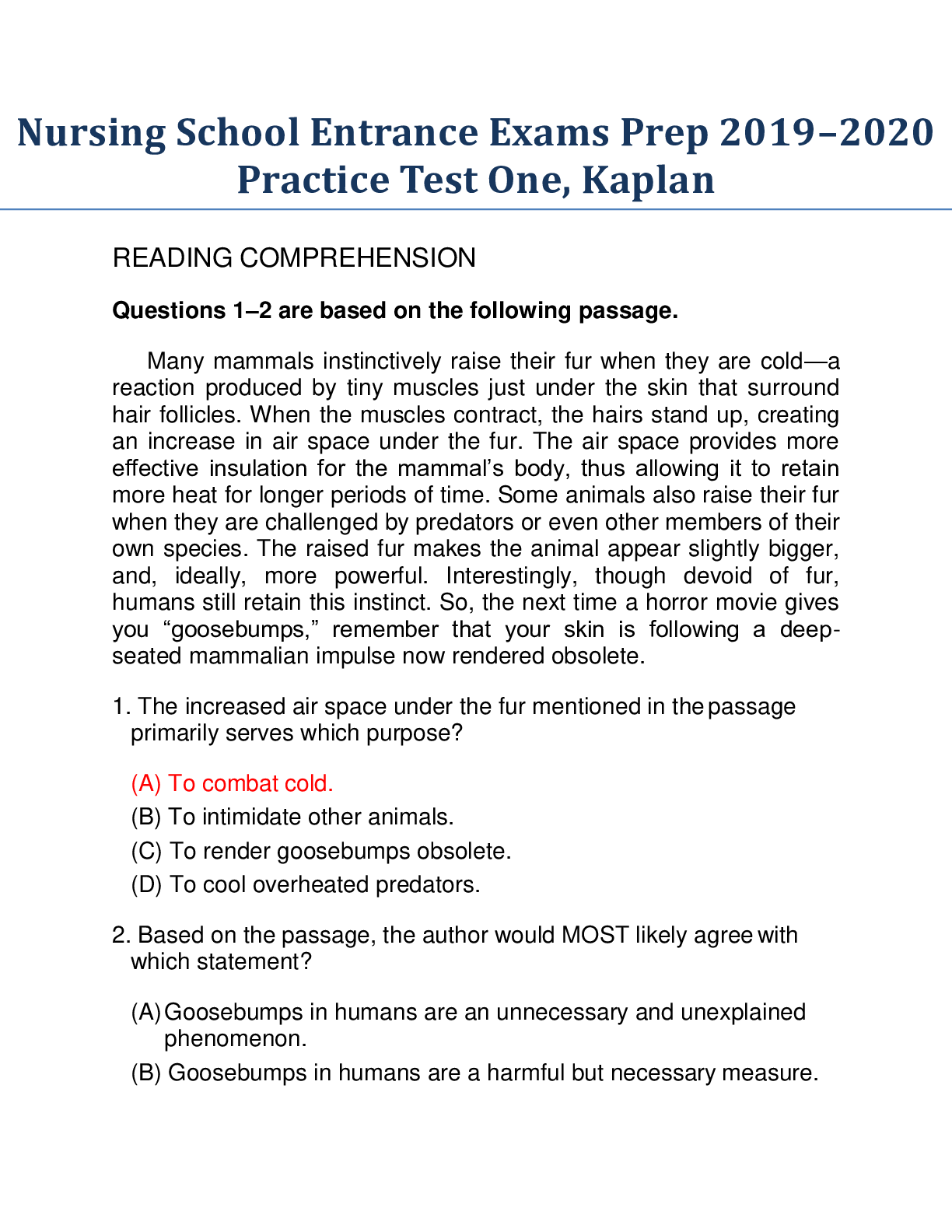
Reviews( 0 )
Document information
Connected school, study & course
About the document
Uploaded On
Jun 17, 2020
Number of pages
32
Written in
Additional information
This document has been written for:
Uploaded
Jun 17, 2020
Downloads
2
Views
399







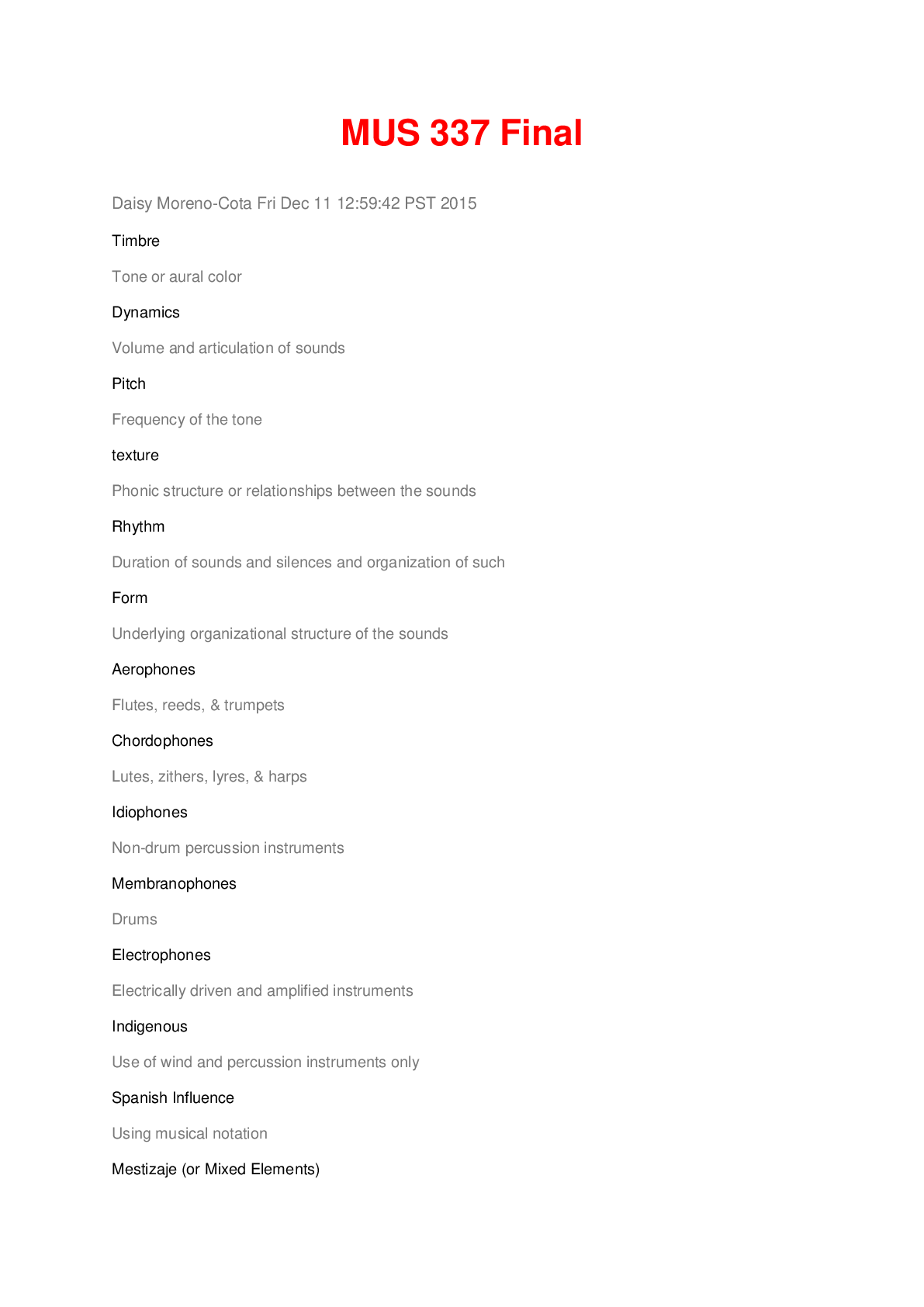




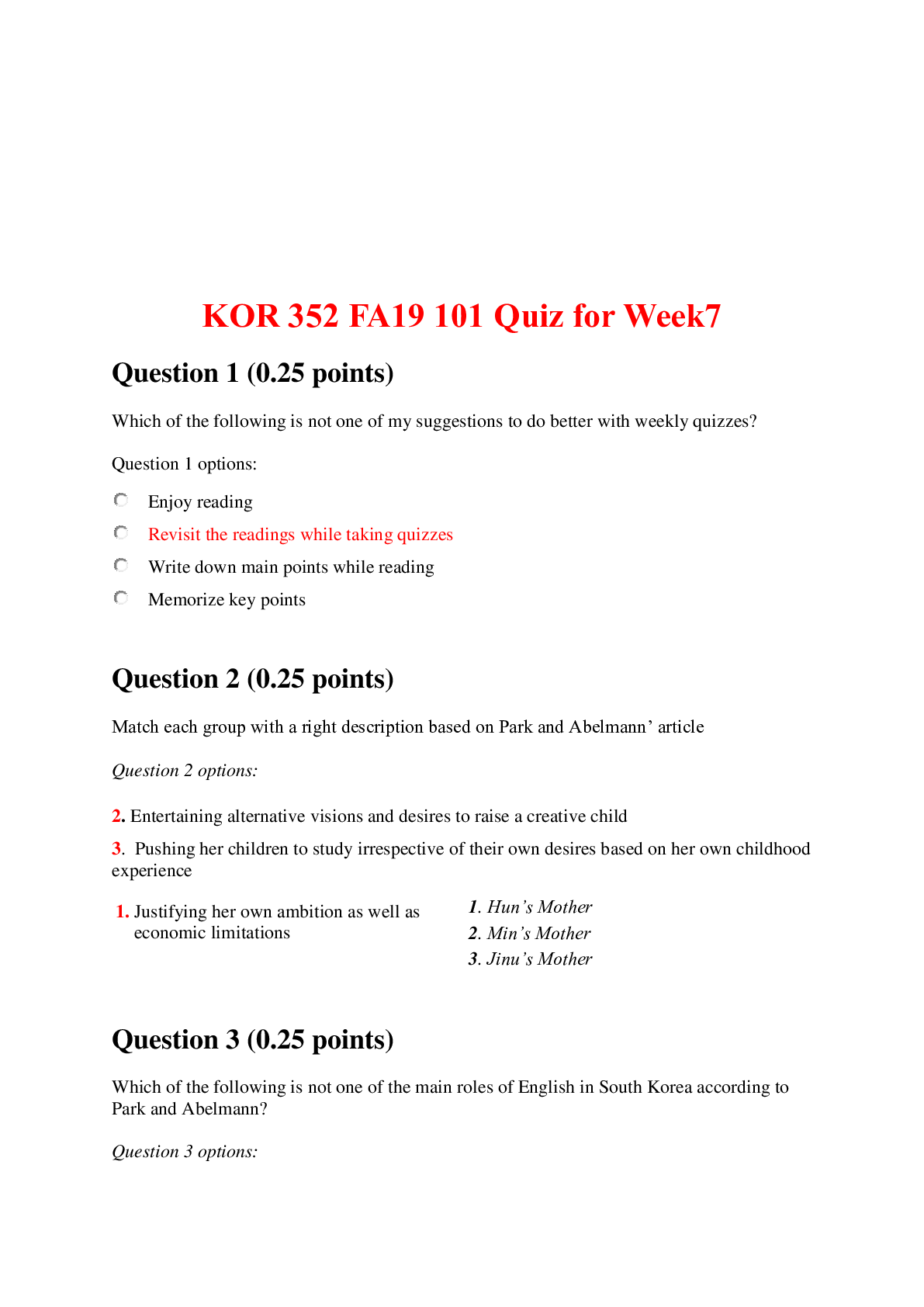


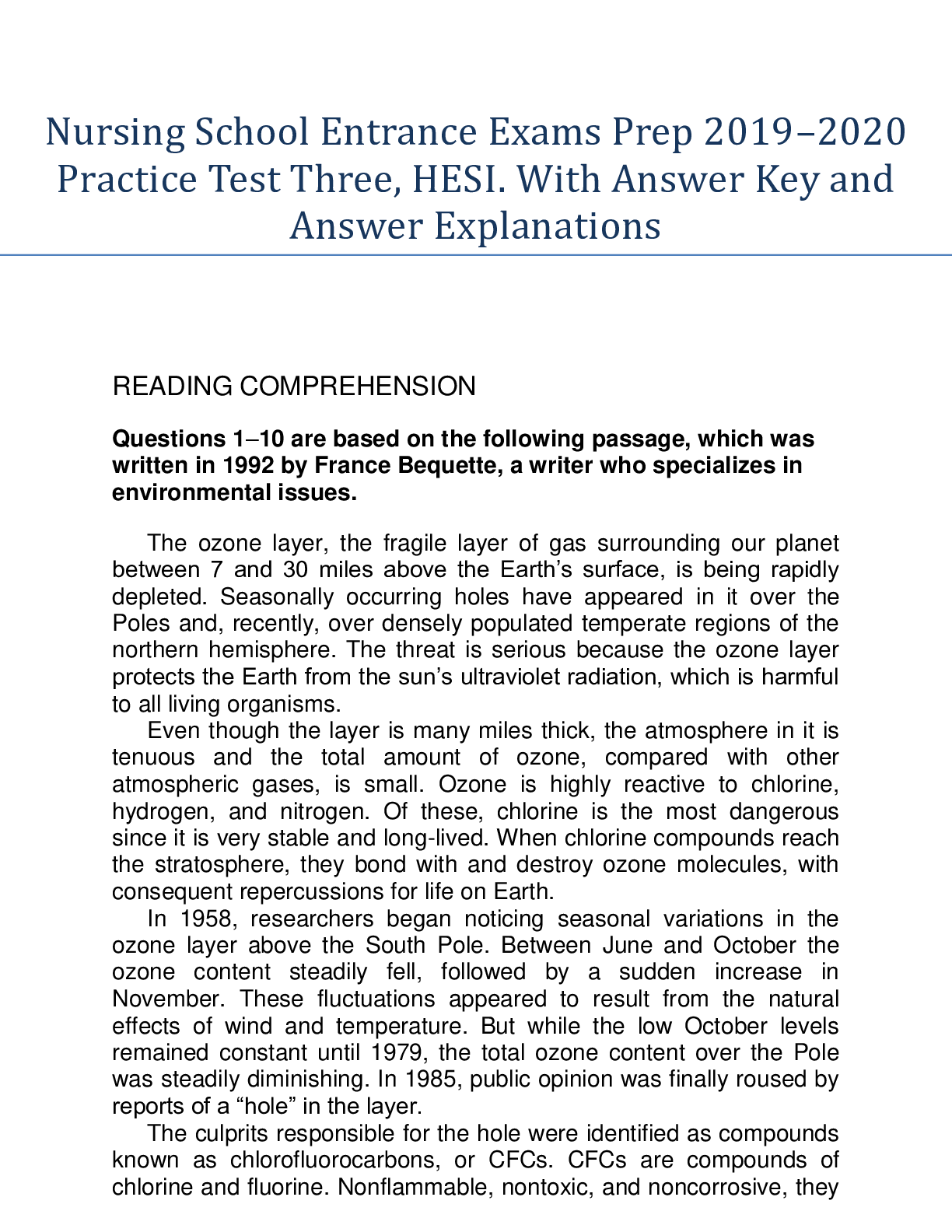
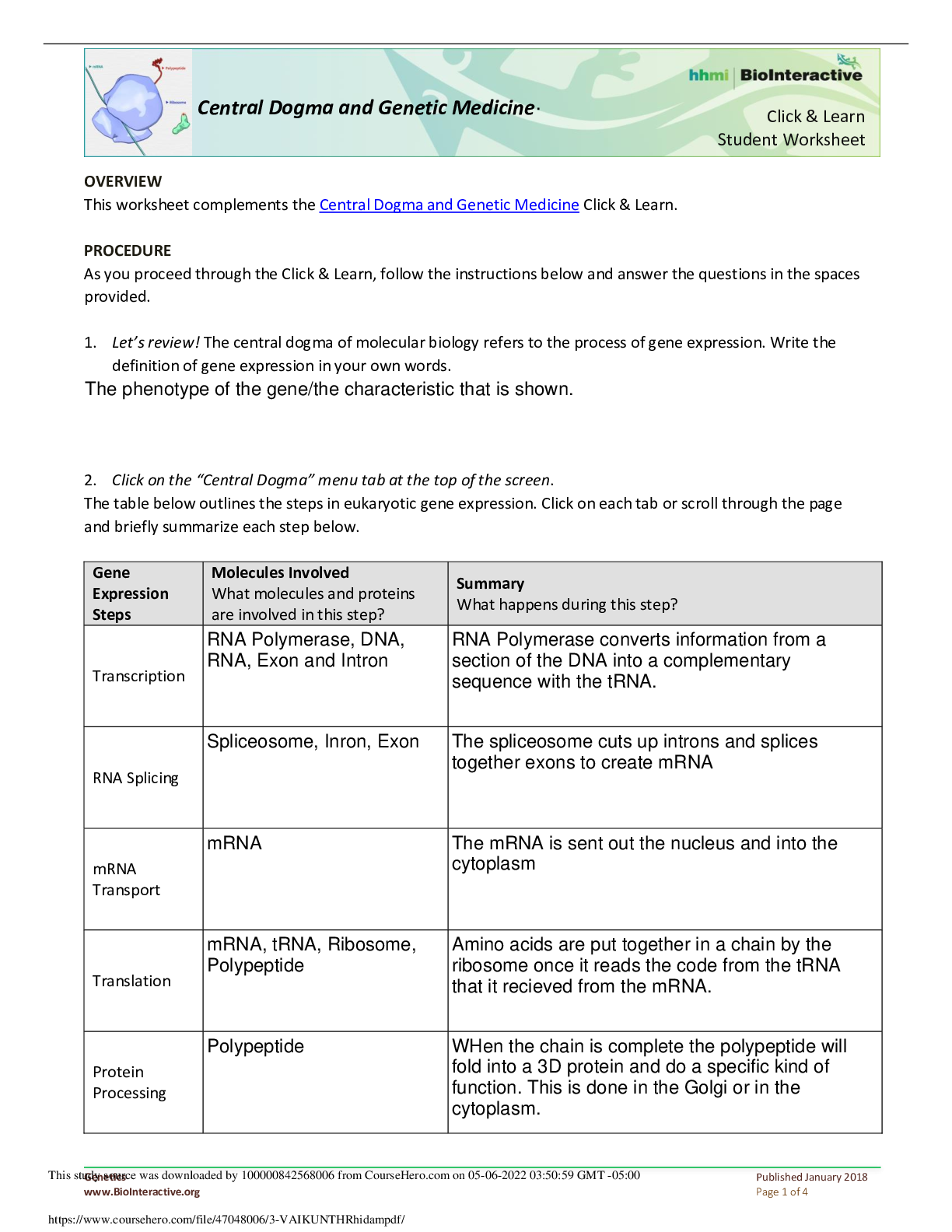
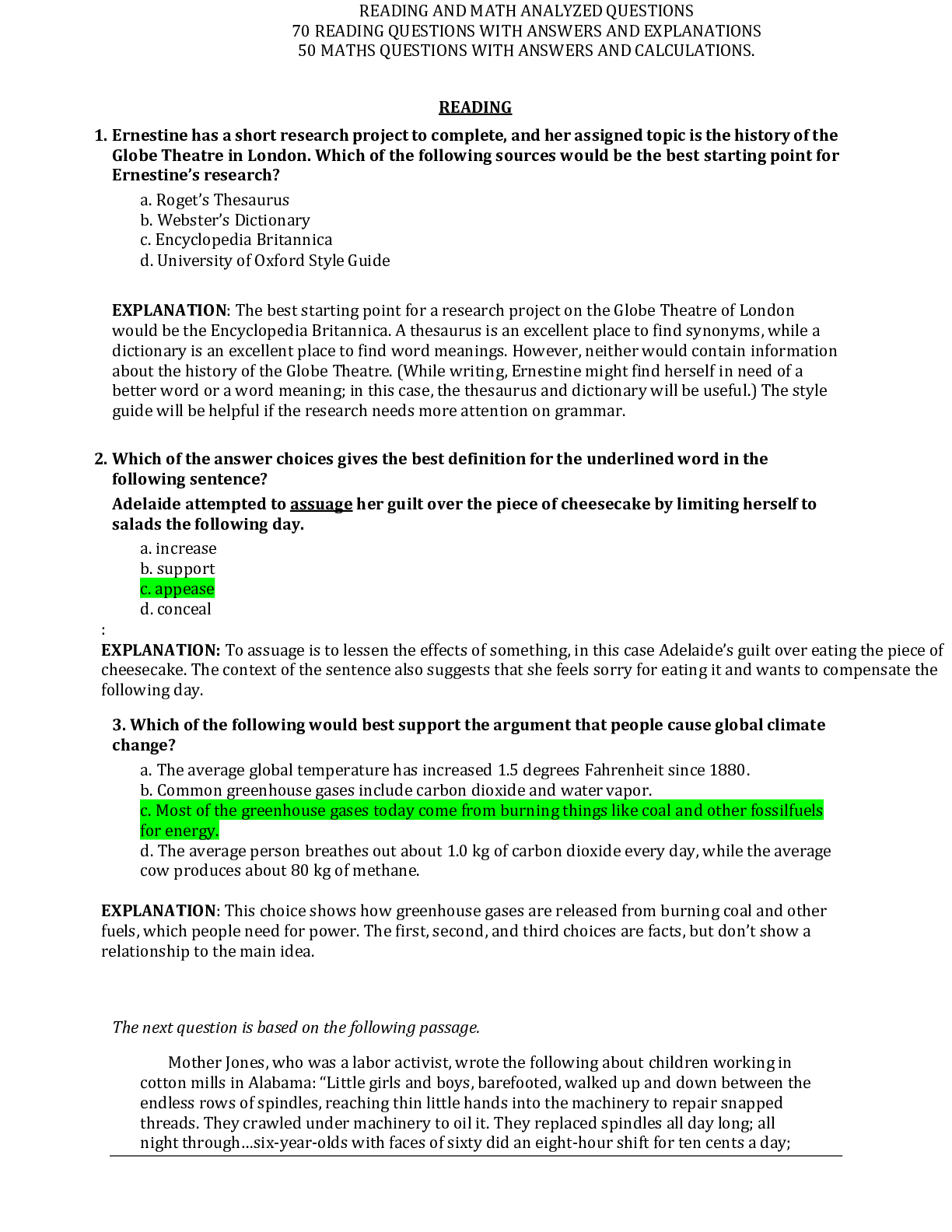
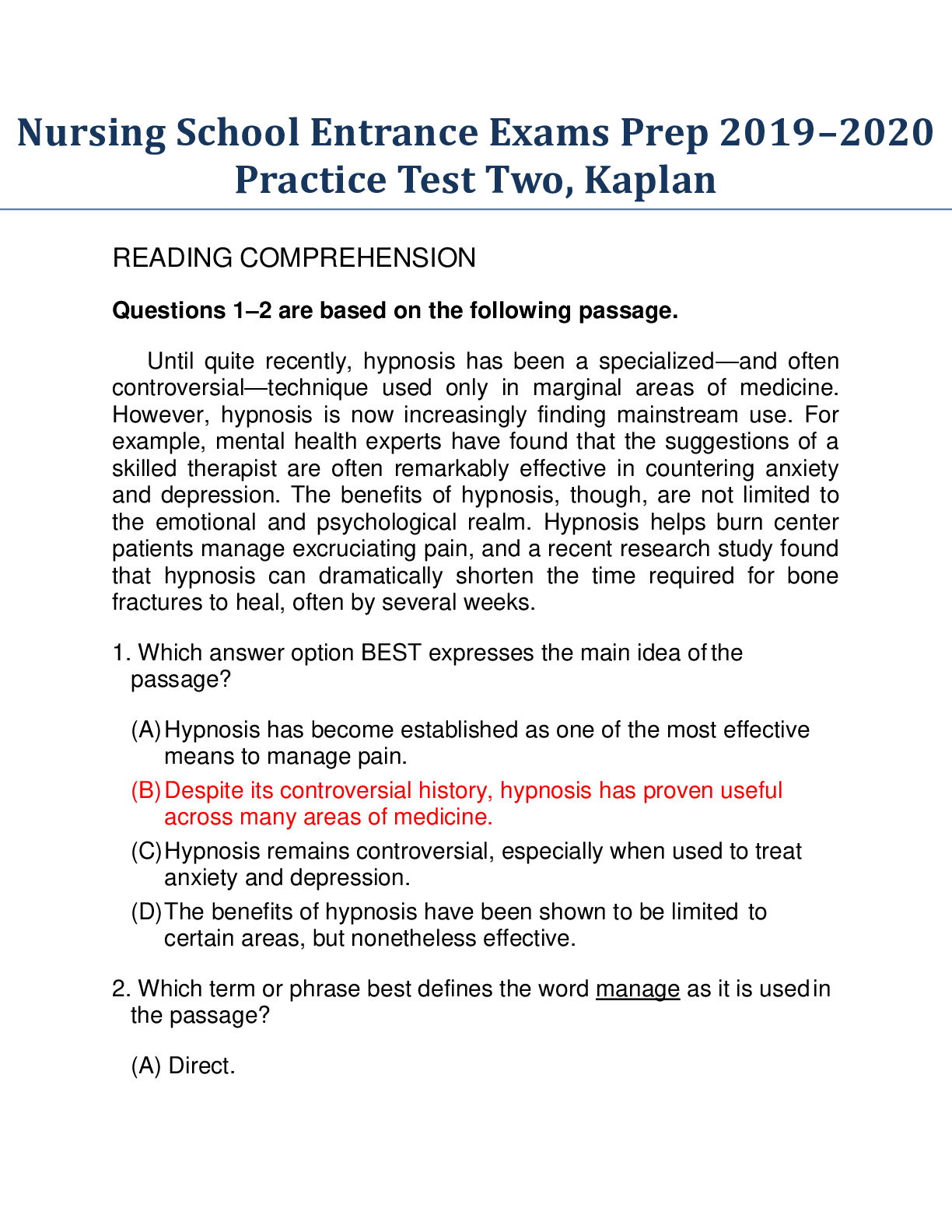

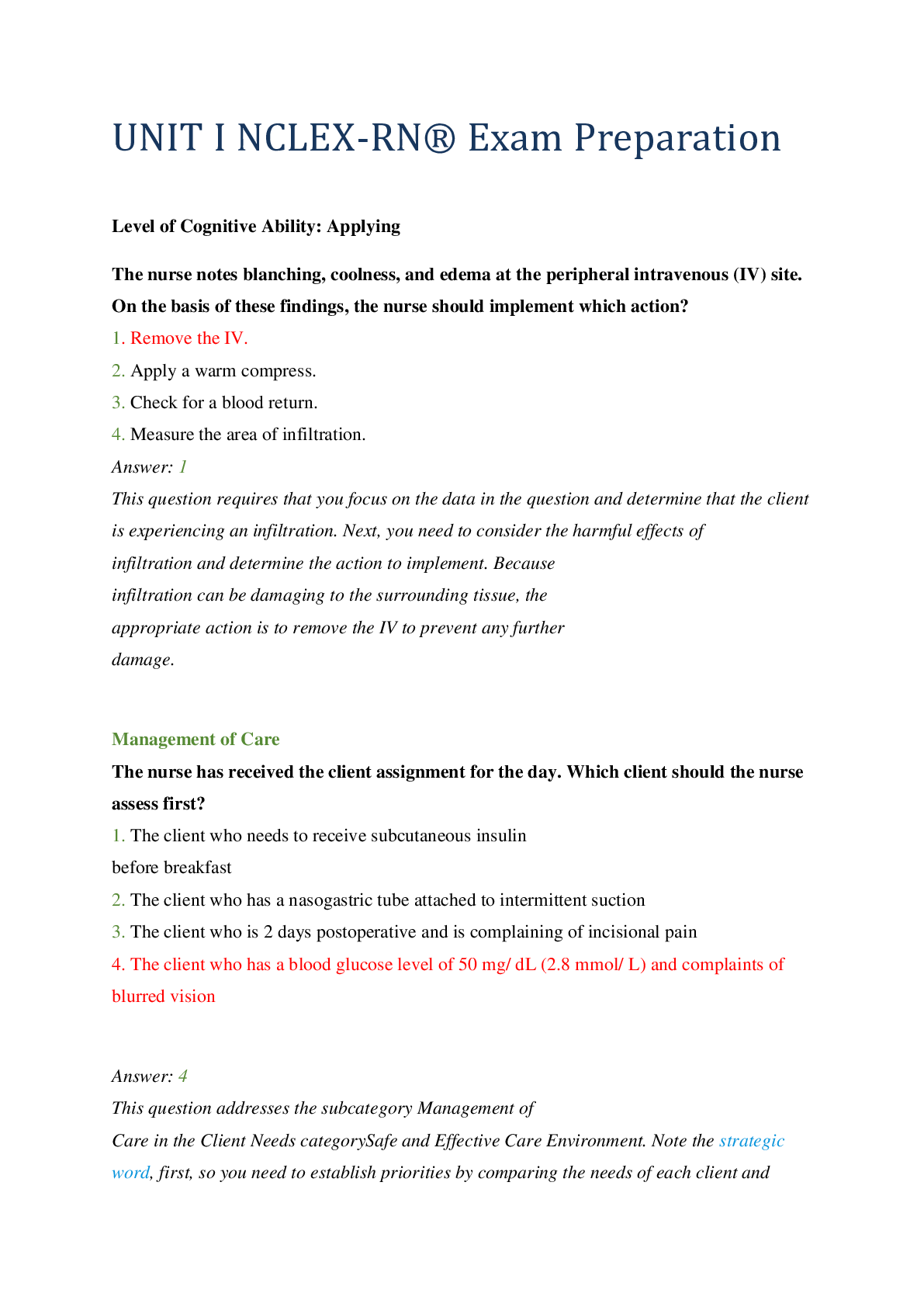
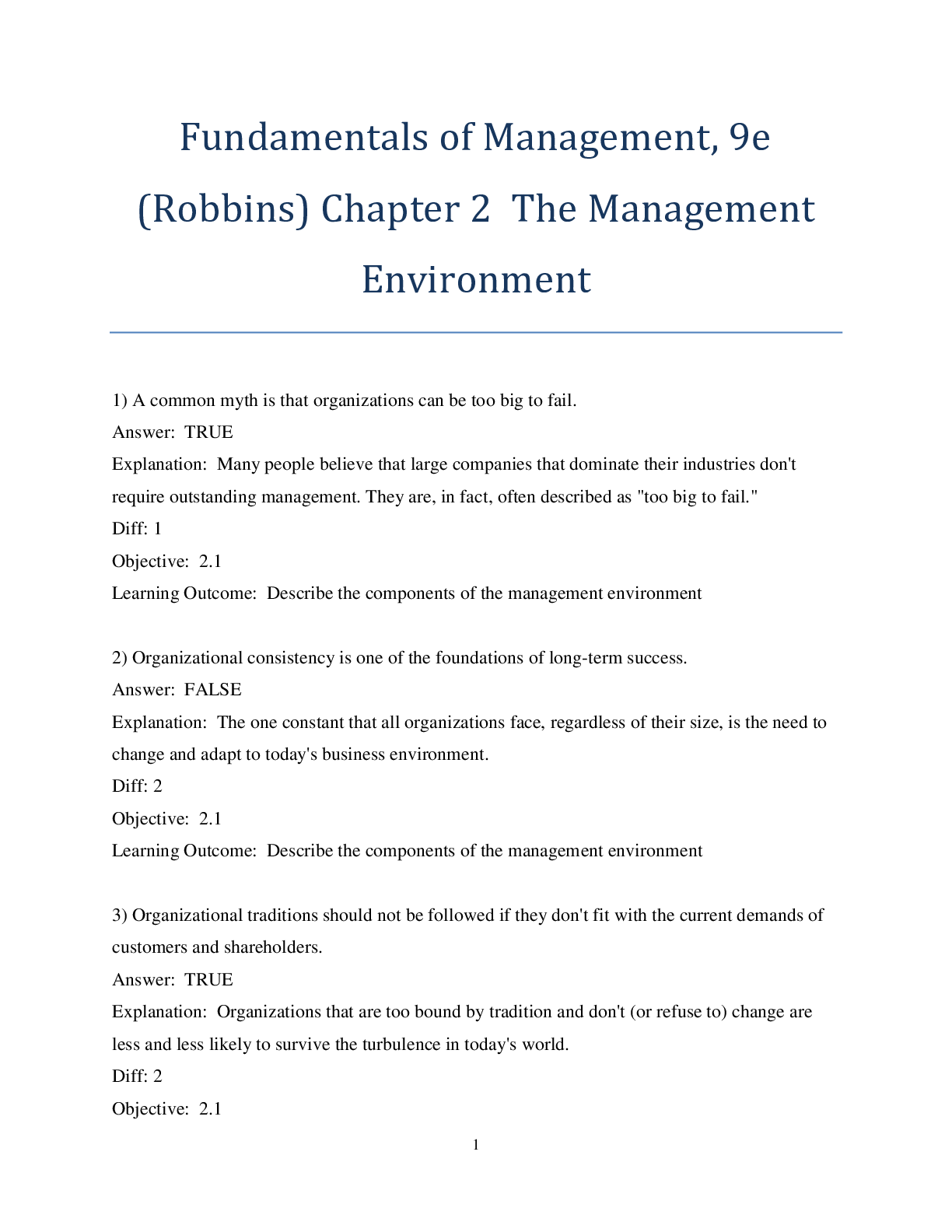
.png)
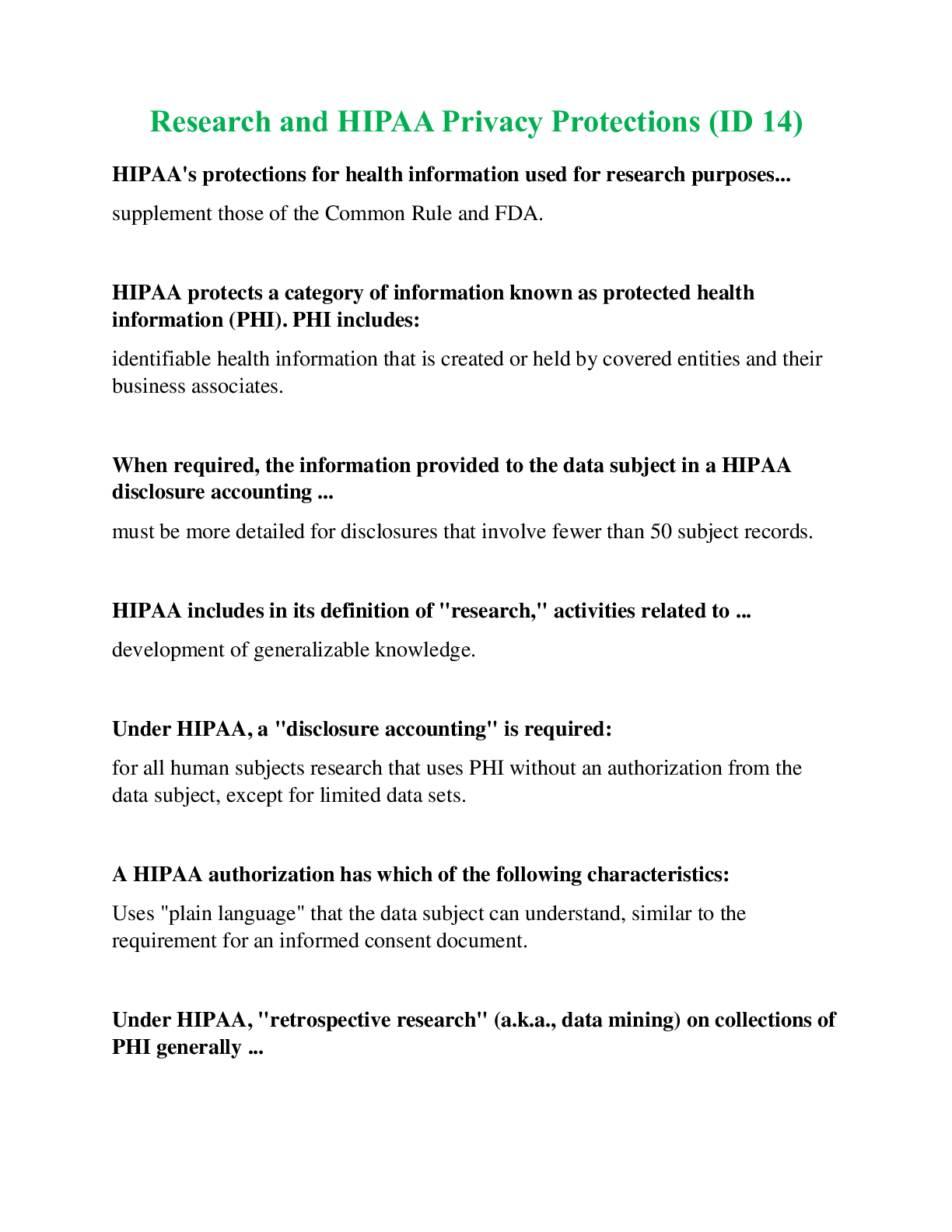


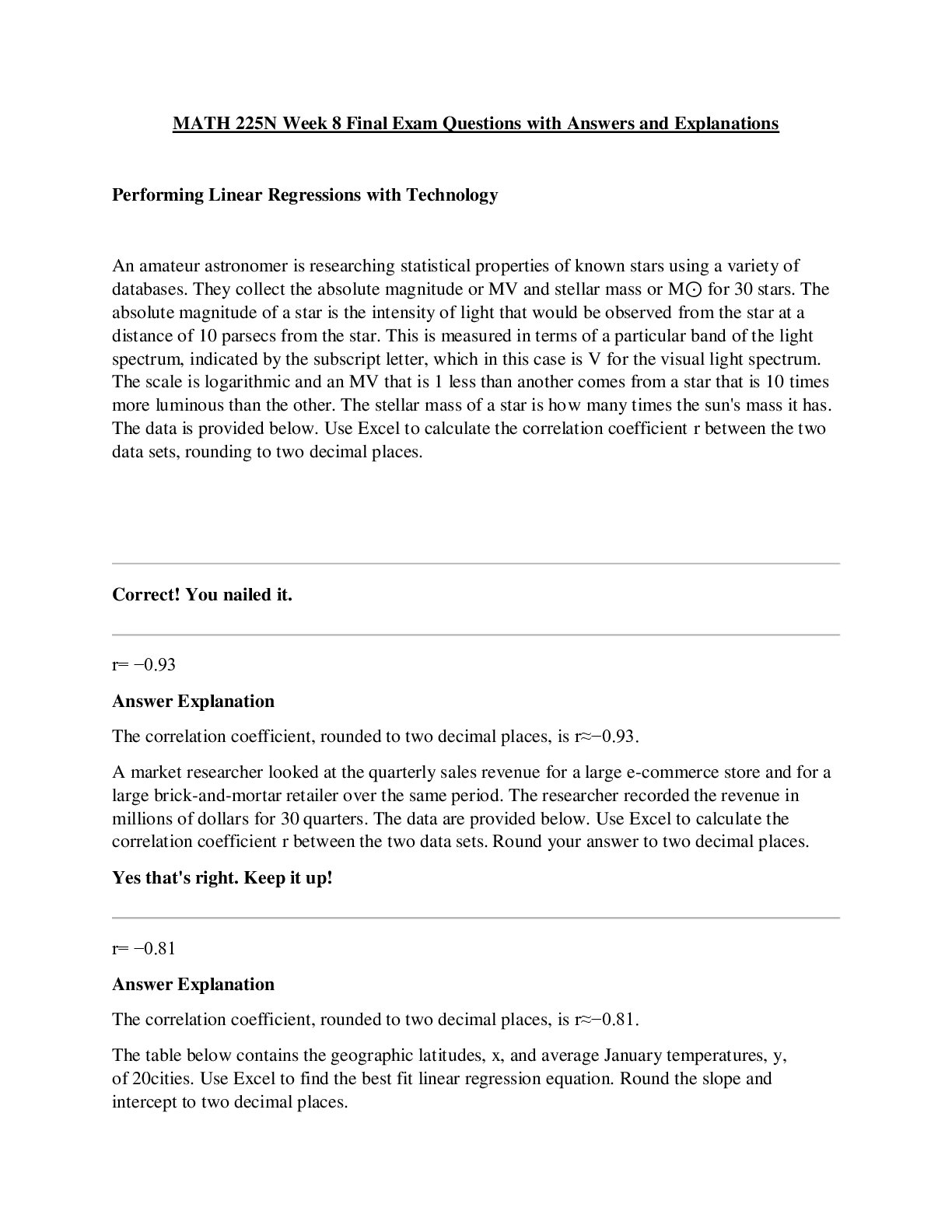
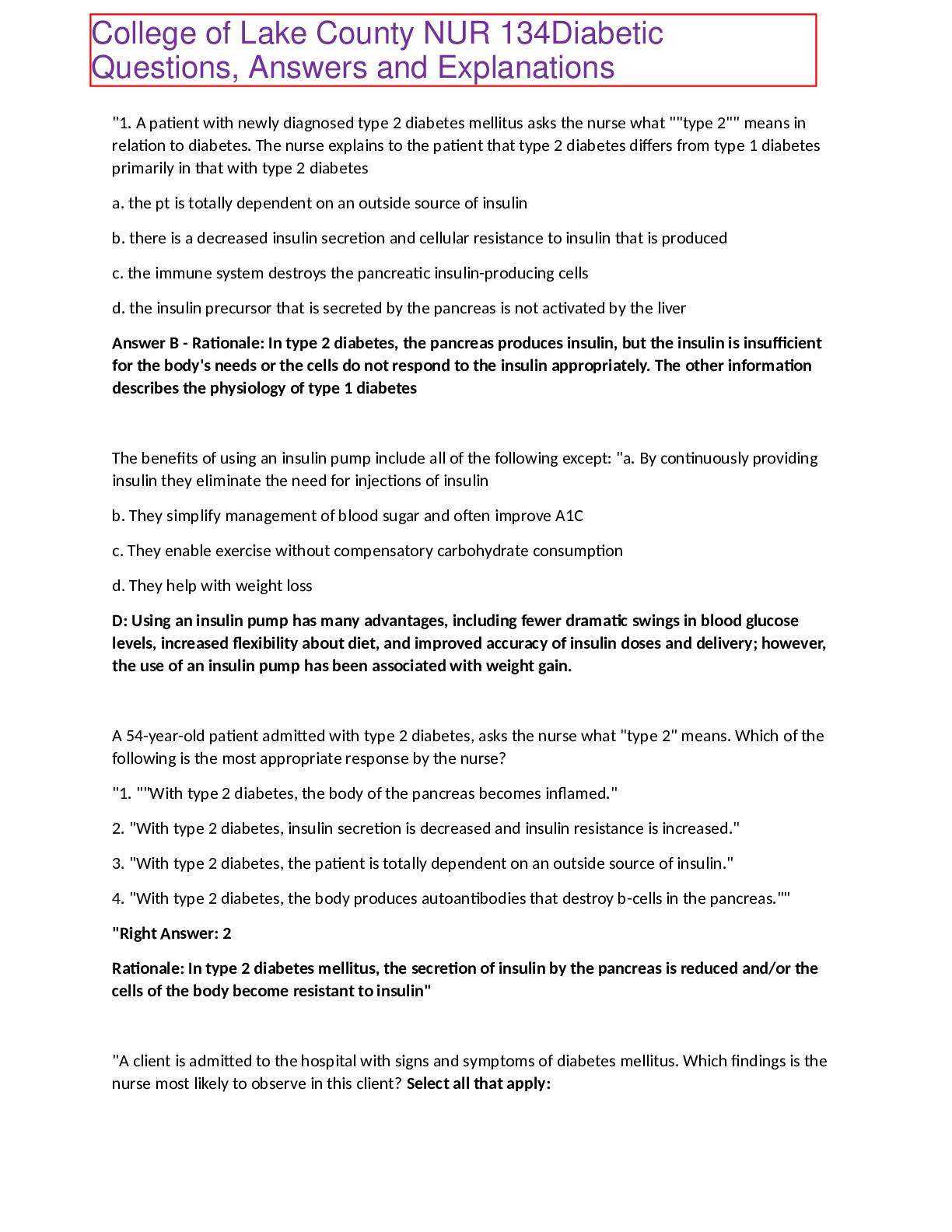
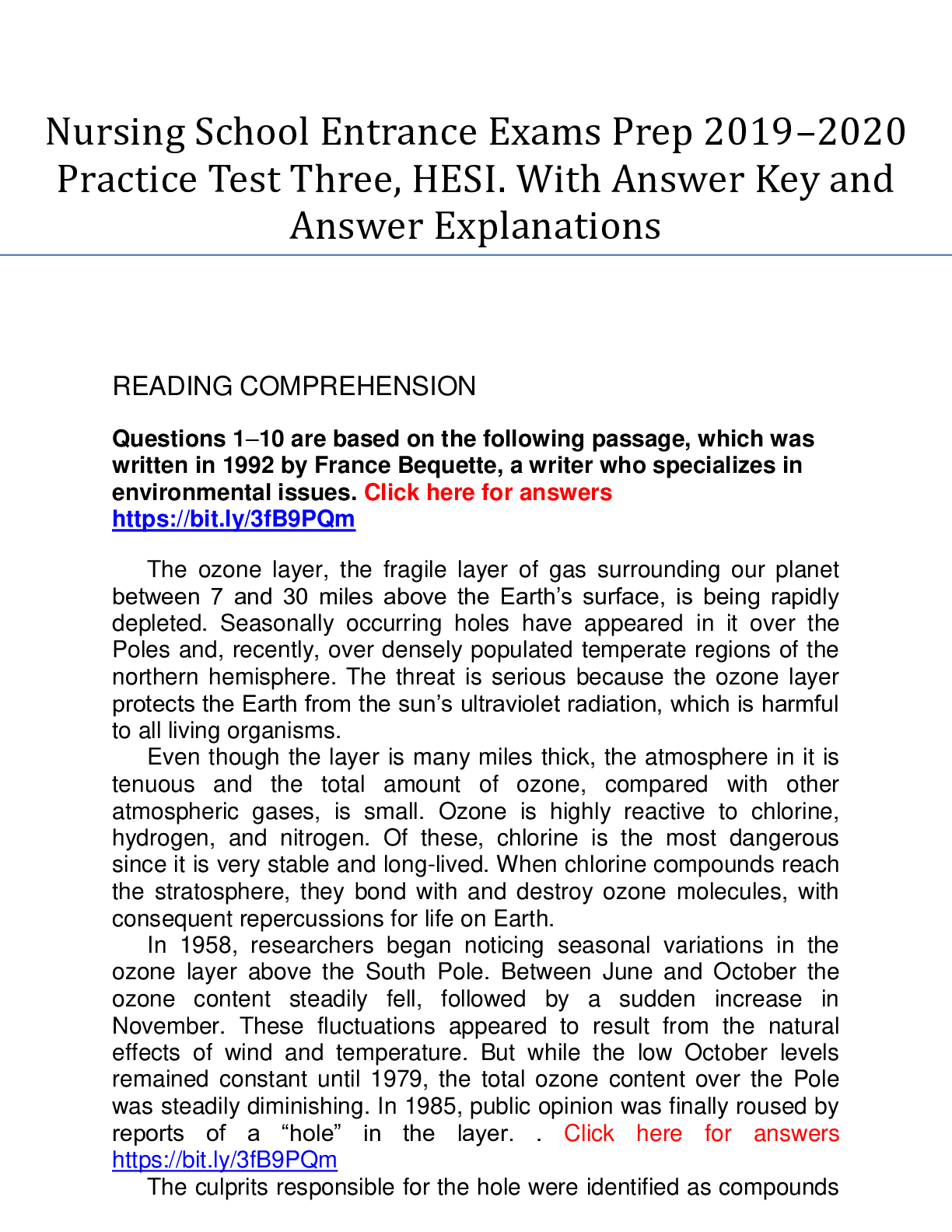


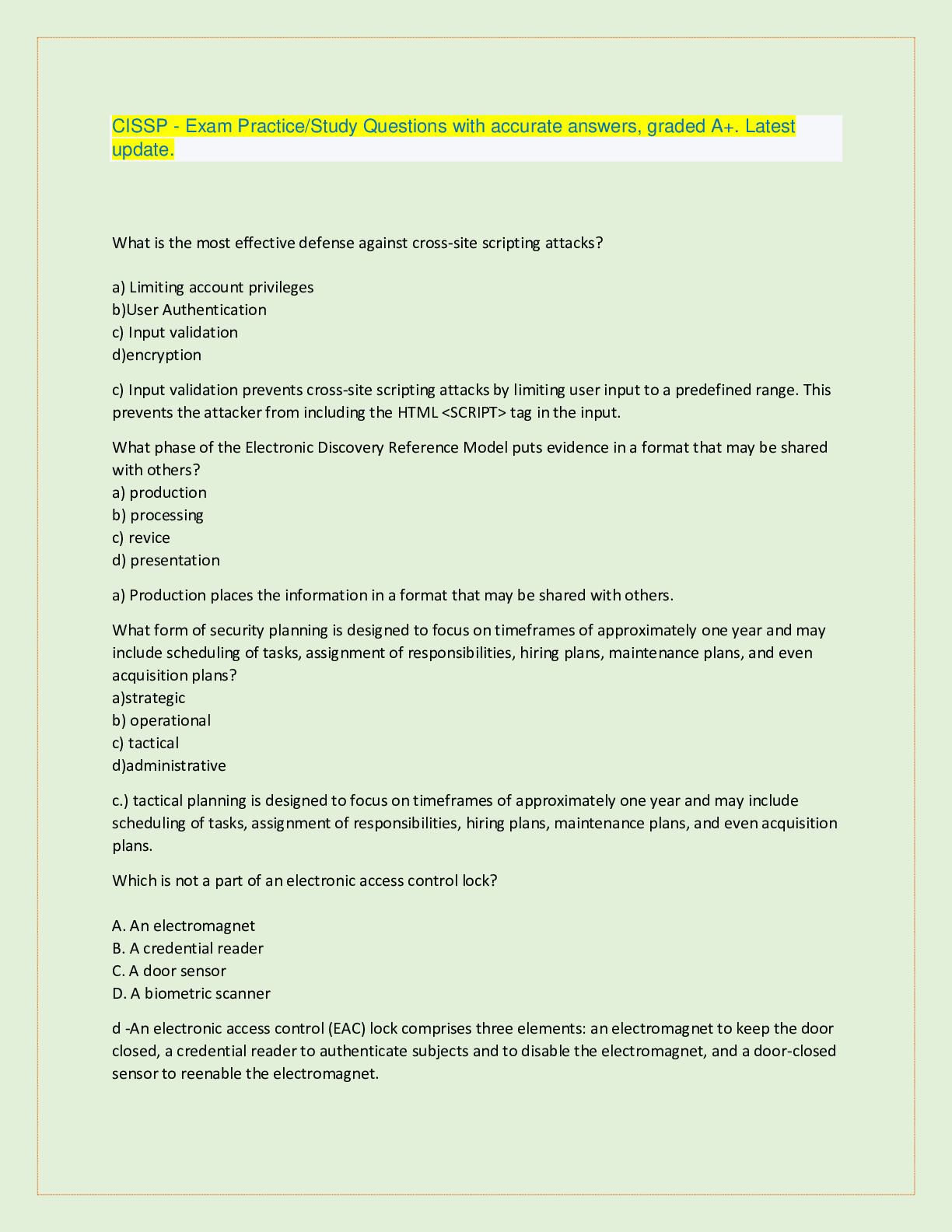

.png)

